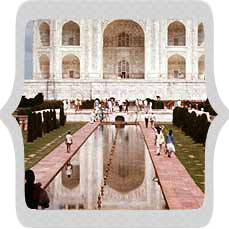This article provides information about the water devices at Taj Mahal. Check out about Taj Mahal waterways.
Water Devices at Taj Mahal
 |
Purs (a rope and bucket pulled by bullocks) were used for drawing water from the river and from there the water was transferred to a huge storage tank. Again thirteen purs were used to pump the water from the tank. From this tank, the water was taken into another huge storage tank through an over-head water-channel. From this tank, water was again pumped through fourteen purs and finally filled into three supply tanks through another channel. The last one of the supply tanks had pipe mouths in its eastern wall. These pipes entered the Taj Mahal enclosure from underground, with one of them moving towards the mosque to supply the fountains in the tanks on the red sandstone plinth below the marble structure. Part of the present water supply still uses the tanks of the old aqueduct, which are filled from wells by electric pumps.
For the fountains in the north-south canal and the lotus pond and its canal, copper pipes were used. To ensure uniform and undiminished water pressure in the fountains, a copper pot was provided under each fountain pipe. The water supply came first into the pot only and from there, rose simultaneously in the fountains, which means that the fountains were controlled by the pressure in the pots rather than pressure in the pipes. The main supply of the water in these pots came through earthenware pipes, some of which were replaced with cast iron back in 1903. And as for irrigational purposes, except for the outlets at the two extreme ends, the whole of the garden is fed with water through interconnected canals. Except for the ramp, most of the water devices at Taj Mahal have stood the test of time and are still present there. And it's the presence of these very water devices that the physical beauty of the Taj has been taken to an ethereal level.